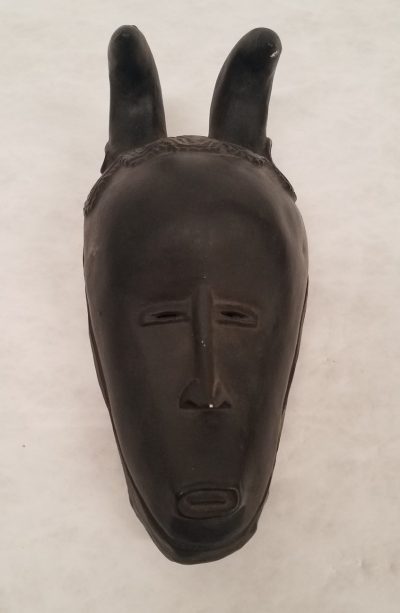Guro Mask (reproduction)
Teaching Collection – Seton Hall University Museum of Anthropology and Archaeology Collection
T2017.01.0001
Courtesy of the Walsh Gallery
SETON HALL UNIVERSITY CELEBRATES AFRICAN AMERICAN HISTORY MONTH
This year’s theme for African American History Month is “Black Family: Representation, Identity and Diversity.” This theme illuminates the African diaspora and the spread of Black families across the United States. This mask, from Seton Hall University’s Museum of Anthropology and Archaeology, is from the Guro (also Gouro) People of the Ivory Coast in West Africa. This region of the continent was profoundly affected by the Transatlantic Slave Trade. An estimated 12 to 12.8 million forced migrations of African people took place over the course of more than 400 years. Those who survived the passage were enslaved in Europe and the Americas.[1]
Despite this trauma, West Africans and African Americans have retained many customs from their respective cultures. Music and dance are two of the most prevalent ways humanity connects with the past, and masks are a powerful and important part of these traditions in West Africa. In many African cultures, including the Guro, masks are potent instruments of unity, family and community.[2] Used in traditional ceremonies and rites such as funerals, weddings and festivals, the masks are activated through music and dance, playing an important role in honoring ancestors and providing community members with palpable links to the past.[3]

Courtesy of Danse traditionnelle du du centre-ouest de la Côte d’Ivoire (Zaouli) à la cérémonie de la flamme de la paix à Bouaké.
Feb 25, 2008
Courtesy of Zenman
In West Africa, secret societies are an important part of community life. The Guro societies are called Je for females and Kne for males. Only members of these secret societies may wear masks and perform in rituals honoring ancestors.[4] Chika Okeke-Agula, a West African performer/curator/artist and art historian explained, “When fully activated, masks become ‘spirits made tangible’.”[5] The mask provides an entry into the spirit world to channel the divine, summon ancestral wisdom, escort the departed, accompany initiates, reaffirm societal values, venerate the living, and to mark the natural cycles of existence, from birth to death, season to season.[6] The ceremonies in which masks are used are called ‘masquerades’ – interventions between the world of the living and the world of the ancestors. During masquerades, the full powers of the masks are released.[7]
The video below from UNESCO shows a masked Guro dancer wearing traditional clothing. Dances are energetic and marked by quick footwork, accompanied by drumming and elaborate costumes. This traditional music and dance known as Zaouli[8] plays an educational, playful and aesthetic role, contributes to environmental preservation, conveys the cultural identity of its bearers and promotes integration and social cohesion among community members.[9]
The Walsh Gallery has a considerable collection of fine art, artifacts and archeological specimens for use by faculty, students and researchers. For access to this or other objects in our collections, contact us at 973-275-2033 or walshgallery@shu.edu to make a research appointment.
[1] https://en.wikipedia.org/wiki/Atlantic_slave_trade#:~:text=Slaves%20were%20imprisoned%20in%20a,a%20span%20of%20400%20years, accessed 1/21/2021.
[2] https://en.wikipedia.org/wiki/Zaouli, accessed 1/21/2021.
[3] https://www.africancraftsmarket.com/products/african-masks/African-Guro-mask.html, accessed 1/21/2021.
[4] https://kwekudee-tripdownmemorylane.blogspot.com/2014/06/guro-gouro-people-artistic-mande-mask.html, accessed 1/25/2021.
[5] https://www.culturesofwestafrica.com/west-african-mask/, accessed 1/26/2021.
[6] Binkley DA. Masks and Masquerades. In: Peek PM, Yankah K, eds. African Folklore: An Encyclopedia. New York, NY, USA: Routledge; 2004:479-485.
[7] Akubor EO. Africans’ concept of masquerades and their role in societal control and stability: Some notes on the Esan people of southern Nigeria. Asian and African Studies. 2016;25(1):32-50.
[8] https://en.wikipedia.org/wiki/Zaouli, accessed 1/26/2021.
[9] https://ich.unesco.org/en/RL/zaouli-popular-music-and-dance-of-the-guro-communities-in-cote-divoire-01255, accessed 1/26/2021.
